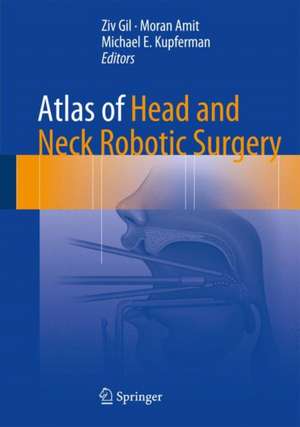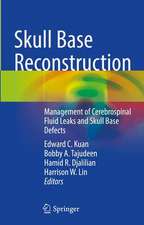Atlas of Head and Neck Robotic Surgery
Editat de Ziv Gil, Moran Amit, Michael E. Kupfermanen Limba Engleză Hardback – 13 iul 2017
Robotic surgery has proved a significant addition to the armamentarium of tools in otolaryngology and head and neck surgery. It is now used in many centers as the workhorse for resection of oropharyngeal and laryngeal tumors, thyroid surgery, and base of tongue resection in patients with obstructive sleep apnea. The da Vinci robotic system, with its three-dimensional vision system, is also excellent for parapharyngeal, nasopharyngeal, and skull base resections. This superbly illustrated book, with accompanying online videos, will be ideal for residents in otolaryngology–head and neck surgery and skull base surgery who are working in a robotic cadaver lab and for specialists seeking to further improve their dissection techniques.
| Toate formatele și edițiile | Preț | Express |
|---|---|---|
| Paperback (1) | 980.40 lei 38-44 zile | |
| Springer International Publishing – aug 2018 | 980.40 lei 38-44 zile | |
| Hardback (1) | 1105.04 lei 22-36 zile | |
| Springer International Publishing – 13 iul 2017 | 1105.04 lei 22-36 zile |
Preț: 1105.04 lei
Preț vechi: 1163.20 lei
-5% Nou
Puncte Express: 1658
Preț estimativ în valută:
211.52€ • 229.83$ • 177.79£
211.52€ • 229.83$ • 177.79£
Carte disponibilă
Livrare economică 31 martie-14 aprilie
Preluare comenzi: 021 569.72.76
Specificații
ISBN-13: 9783319495767
ISBN-10: 3319495763
Pagini: 257
Ilustrații: X, 230 p. 162 illus., 155 illus. in color.
Dimensiuni: 178 x 254 x 15 mm
Greutate: 0.69 kg
Ediția:1st ed. 2017
Editura: Springer International Publishing
Colecția Springer
Locul publicării:Cham, Switzerland
ISBN-10: 3319495763
Pagini: 257
Ilustrații: X, 230 p. 162 illus., 155 illus. in color.
Dimensiuni: 178 x 254 x 15 mm
Greutate: 0.69 kg
Ediția:1st ed. 2017
Editura: Springer International Publishing
Colecția Springer
Locul publicării:Cham, Switzerland
Cuprins
Part I Background and Establishing a Robotics Team: 1. Robotics in Surgery.- 2. Robotic Instrumentation, Personnel and Operating Room Setup.- 3. Robotic Surgery Training.- 4. Anatomical considerations in transoral robotic approach.- Part II Trans Oral Robotic Surgery: 5. Tonsillar cancer.- 6. Base of tongue cancer .- 7. Laryngeal cancer (online video).- 8. Surgery for obstructive sleep apnea.- Part III Endocrine Robotic Surgery: 9.Hemi and total thyroidectomy.- 10. Parathyroidectomy.- Part IV Other robotic approaches: 11. Robotic assisted neck surgery.-12.Robotic assisted surgery of parapharyngeal space tumors.- 13. Robotic approaches to the midface and skull base.-14. Robotic procedures in the pediatric population.- Part V Ancillary issues in robotic surgery: 15. Robotic reconstructive surgery.- 16. Complications and postoperative care.- 17. Novel instrumentation and methods in head and neck robotic surgery.- 18. Intraoperative imaging and navigation in robotic surgery.
Notă biografică
Professor Gil is a Barbara S. Goodman Endowed Investigator (ICRF) and the Chairman, Department of Otolaryngology Head and Neck Surgery, Rambam Healthcare Campus, Israel Institute of Technology. Holding an MD and PhD in Biophysics and Neuroscience, he is Head of the Applied Cancer Research Laboratory and a member of the Rappaport Research Institute and the Clinical Research Institute at Rambam. He has received awards from the Israeli Parliament, NY Head and Neck Society, Israeli Cancer Society and Folks Foundation. The author of 3 books and over 200 scientific publications and book chapters, Dr Gil has established new techniques in skull base and robotic surgery. He serves on the Editorial Boards of multiple journals including Otolaryngology Head and Neck Surgery, Journal of Neurological Surgery, and Head and Neck. In 2014 he established the first comprehensive Head and Neck Center in Israel.
Moran Amit, MD, PhD, completed his training in Head & Neck Surgery at the University of Texas MD Anderson Cancer Center, Houston, Texas, USA. His clinical focus is on robotic head and neck surgery and functional rehabilitation of head and neck cancer patients. Dr. Amit is a co-founder of the Adenoid Cystic Carcinoma International Study (AXIS) Group and a member of the International Consortium for Outcome Research (ICOR) in Head and Neck Cancer. Having published extensively on oral cavity, skull base and salivary gland cancer, he has received multiple AHNS and Israeli Cancer Society awards for his research on tumor immunology and resistance to treatment. Dr. Amit is a Barbara S. Goodman Endowed Investigator (ICRF).
Dr. Michael Kupferman is an Associate Professor of Head & Neck Surgery at the University of Texas MD Anderson Cancer Center. He obtained his medical degree from the University of Pennsylvania School of Medicine and completed a residency at the Hospital of the University of Pennsylvania. After completing a two-year fellowship at MD Anderson Cancer Center (MDACC), he joined the faculty of the Department of Head and Neck Surgery, where he is an active member of the Skull Base Tumor Program. A respected expert in robotic surgery and in the management of thyroid cancer, Dr. Kupferman is also medical director of the Voice Center at MD Anderson. He also represents the MDACC across all national and international locations, making him responsible for evaluating surgical standards and practices and providing expertise in oncology across all disciplines.
Moran Amit, MD, PhD, completed his training in Head & Neck Surgery at the University of Texas MD Anderson Cancer Center, Houston, Texas, USA. His clinical focus is on robotic head and neck surgery and functional rehabilitation of head and neck cancer patients. Dr. Amit is a co-founder of the Adenoid Cystic Carcinoma International Study (AXIS) Group and a member of the International Consortium for Outcome Research (ICOR) in Head and Neck Cancer. Having published extensively on oral cavity, skull base and salivary gland cancer, he has received multiple AHNS and Israeli Cancer Society awards for his research on tumor immunology and resistance to treatment. Dr. Amit is a Barbara S. Goodman Endowed Investigator (ICRF).
Dr. Michael Kupferman is an Associate Professor of Head & Neck Surgery at the University of Texas MD Anderson Cancer Center. He obtained his medical degree from the University of Pennsylvania School of Medicine and completed a residency at the Hospital of the University of Pennsylvania. After completing a two-year fellowship at MD Anderson Cancer Center (MDACC), he joined the faculty of the Department of Head and Neck Surgery, where he is an active member of the Skull Base Tumor Program. A respected expert in robotic surgery and in the management of thyroid cancer, Dr. Kupferman is also medical director of the Voice Center at MD Anderson. He also represents the MDACC across all national and international locations, making him responsible for evaluating surgical standards and practices and providing expertise in oncology across all disciplines.
Textul de pe ultima copertă
This atlas offers precise, step-by-step descriptions of robotic surgical techniques in the fields of otolaryngology and head and neck surgery, with the aim of providing surgeons with a comprehensive guide. The coverage encompasses all current indications and the full range of robotic surgical approaches, including transoral, transaxillary, transmaxillary, and transcervical. Key clinical and technical issues and important aspects of surgical anatomy are highlighted, and advice is provided on ancillary topics such as postoperative care and robotic reconstructive surgery.
Robotic surgery has proved a significant addition to the armamentarium of tools in otolaryngology and head and neck surgery. It is now used in many centers as the workhorse for resection of oropharyngeal and laryngeal tumors, thyroid surgery, and base of tongue resection in patients with obstructive sleep apnea. The da Vinci robotic system, with its three-dimensional vision system, is also excellent for parapharyngeal, nasopharyngeal, and skull base resections. This superbly illustrated book, with accompanying online videos, will be ideal for residents in otolaryngology–head and neck surgery and skull base surgery who are working in a robotic cadaver lab and for specialists seeking to further improve their dissection techniques.
Robotic surgery has proved a significant addition to the armamentarium of tools in otolaryngology and head and neck surgery. It is now used in many centers as the workhorse for resection of oropharyngeal and laryngeal tumors, thyroid surgery, and base of tongue resection in patients with obstructive sleep apnea. The da Vinci robotic system, with its three-dimensional vision system, is also excellent for parapharyngeal, nasopharyngeal, and skull base resections. This superbly illustrated book, with accompanying online videos, will be ideal for residents in otolaryngology–head and neck surgery and skull base surgery who are working in a robotic cadaver lab and for specialists seeking to further improve their dissection techniques.
Caracteristici
Describes techniques step by step with the aid of numerous illustrations
Highlights differences between standard operations and alternative techniques
Explains how to avoid complications
Written by leading experts from the MD Anderson Cancer Center and University of Pennsylvania Medical Center
Highlights differences between standard operations and alternative techniques
Explains how to avoid complications
Written by leading experts from the MD Anderson Cancer Center and University of Pennsylvania Medical Center




























